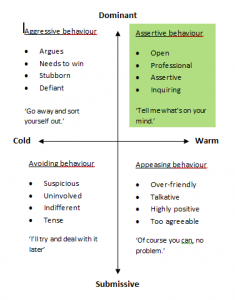By Sandie Shaw
There are certain conversation that we all find difficult. Whether at work, at home or in a social context. At some time or another we will find ourselves preparing for a difficult conversation.
“I’m sorry, it’s just not working out”
“Can we talk about my salary?”
“I strongly disagree with what you’re saying.”
There are certain conversations that we all find difficult, whether at work, at home or in a social context. At some time or another we will find ourselves preparing for a difficult conversation.
At times like this your heart may start to beat faster and your palms may begin to feel clammy. It is easy to be distracted by these anxious feelings which in turn can hinder your ability to stay calm and communicate clearly what is on your mind. At worst you may lose control of what you are thinking and saying and may even lose sight of how your words are being received… the conversation can get ugly.
Lets begin my taking a look at how we might respond in such a situation. The Thomas-Kilmann Conflict Model provides a coaching theory I sometimes discuss with my client to help them consider how difficult situations may be affecting their communication and behaviour. The diagram below highlights four different types of behaviour in terms of warm and cold, dominant and submissive.

Can you identify with one particular style of behaviour more than another?
The ideal communication style is outlined in the top right. The characteristics of this are Warm and Dominant. ‘Warm’ meaning friendly, approachable, honest and empathetic. ‘Dominant’ meaning confident, strong, clear and focused.
If you find yourself leaning more towards cold behaviour; either aggressive or submissive, in preparation for, or during a difficult conversation, then it’s time to consider what to do to get yourself back into a more resourceful state. Taking a step back from the situation, even just for a second, will give you a chance to reflect. The desire to change your state will give way to changes in your body language, tonality and the words you use, and will have a positive effect on you and the person you are talking to. As outlined in the diagram above, communication that aims to be warm, assertive and flexible will often allow you to think clearly and respond effectively to most responses. Even if you don’t get exactly the outcome that you were hoping for, you will find yourself in a good position to negotiate and to propose a compromise that you can both be happy with. Maintaining rapport and trying to keep the communication warm, friendly and clear allows us to find creative ways to explore and meet our own needs and the needs of others.
Six ways to successfully manage a difficult conversations.
- Be prepared. Spend adequate time considering what you want to achieve by having the conversation. Write down the key point you want to raise and list any further points in order of importance. What would your ideal outcome be for each point? If you would like their input with finding a solution, or if you have a proposal for a solution of your own, write them down next to each point. Picture yourself confidently and assertively raising the issues on your list and explaining your ideas for possible solutions.
- Put yourself in their shoes. How would you receive this information? Anticipating their response will help you to consider carefully your language and your body language and be more prepared for their response, including the possibility of an emotional response.
- Consider the most appropriate time and place for the conversation. Chose a time and place when you will both feel comfortable, will not be rushed for time and without the fear of being interrupted. If necessary, reassure the person you’re talking to that the conversation is confidential. Have a time frame in mind before you start talking. If it becomes clear that the conversation is going to take longer, don’t be tempted to rush things through or run over time. The last thing you both want is to feel exhausted by the conversation and late for your next appointment, or worse, to make a poor decisions. Agree to meet again to continue the conversation at another suitable time.
- Indicate that you want a constructive conversation. Think about what your body language is saying; does it signal that you are approachable, non-threatening and ready to talk and listen? Don’t skirt around the issue – once you have thanked them for their time, stick to the preparation you did in advance of the conversation. Stay in control. If you find your tonality changing, either speeding up and getting louder (getting frustrated) or slowing and getting quieter (losing confidence), adjust your posture. Whether you are sitting or standing, change your physiology to be more relaxed or more assertively and your tone of voice and language will follow suit.
- Avoid hightening emotions by using ‘I’ instead of ‘You’. When dealing with inappropriate behaviour, instead of pointing the finger of blame, which makes people want to defend themselves, start by explaining how the behaviour effected you. ‘I was very disappointed that you missed the appointment yesterday…’ instead of ‘You missed a very important meeting again.’
- Stay focused on solutions and future goals. It is more fruitful to ask ‘How can we do better next time?’ then ‘Why did it go wrong?’. We can not change the past but we can explore and identify the best way to move forward for future success.
If you are working through some tough decisions or need advice on handling difficult conversations, why not get in touch for a free consultation. I can’t make the problem disappear but I can certainly help you to put your best foot forward. Call Sandie on 07985 284 914.
Best wishes,
Sandie,
High Peak Life Coach

